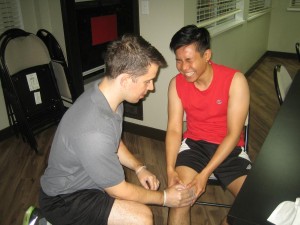Hematoma is a medical term used to describe the accumulation of blood in the tissues because of bleeding; for instance, when the small vessels rupture or tear due to injuries like fall or bump. Hematomas usually accumulate under the skin, the muscles, tissues, periosteum and internal organs. Sometimes it is caused by diseases in the vessels such as atherosclerosis, but usually, hematomas are caused by minor soft tissue injuries such as bruising and painful swelling.
The appearance of hematomas can be prevented with proper first aid technique. And if proper treatment is rendered, hematomas usually disappear without leaving a trace of bruise on the skin. Most hematomas caused by minor injuries can be treated at home, but larger ones, which affect the intramuscular cavity, usually need medical assistance and treatment.
What are the symptoms of hematoma?
Swelling is the first sign of hematoma, which is relatively fast-increasing in size and lump. The swelling then disappears and there is no initial sign of inflammation noted on the site of the injury. But after the 3rd to 5th day, there is a reactive tissue inflammation that develops on the site. Also along the edge of the hematoma, swelling and inflammation can be noted. If the hematoma is touched, there is a painful sensation, warm to touch, and mild soreness. But whenever the hematoma becomes severely inflamed after the first 5 days, the swelling becomes hotter and more painful to touch. The victim may also suffer from elevated body temperature because of infection on the injury site.

Other common symptoms of hematoma include limited mobility or movement on the affected extremities, muscle groups or skin region and skin discoloration usually from purplish-red to yellowish-green.
When can a hematoma become dangerous or life-threatening?
As we have said, mild hematomas can be treated at home and are less dangerous. But when hematomas develop from severe crash, fall, other inadvertent circumstances, and medical conditions, it usually needs immediate medical supervision. For instance, a hematoma that occurs in the brain can result to a traumatic brain injury, resulting to intracerebral hematoma. This kind of hematoma is life-threatening and needs to be treated medically as soon as possible, because it can cause paralysis or even death if not treated promptly.
Ways to treat mild hematomas
There are several conservative ways to treat hematomas at home. Immediately after bruising, apply ice to the injury site and compression band to prevent hematomas from developing. Usually after 2 to 3 days, it needs to be massaged and applied with heat to help return the normal blood circulation on the site of the injury. Always remember that hematoma gradually improve over time, but if it there is too much pain on the site, over-the-counter pain medications can usually be taken to minimize inflammation and pain.
Related Video on Hematoma Treatments:
[youtube url=”https://www.youtube.com/watch?v=HxjMvm80bGg” width=”220″]Sources:
“Hematoma Treatment.” Emedicine Health. Retrieved online on July 31, 2014 from http://www.emedicinehealth.com/hematoma/page7_em.htm#hematoma_self-care_at_home
“What is a Hematoma?” About.com Sports Medicine. Retrieved online on July 31, 2013 from http://sportsmedicine.about.com/od/glossary/g/hematoma_def.htm